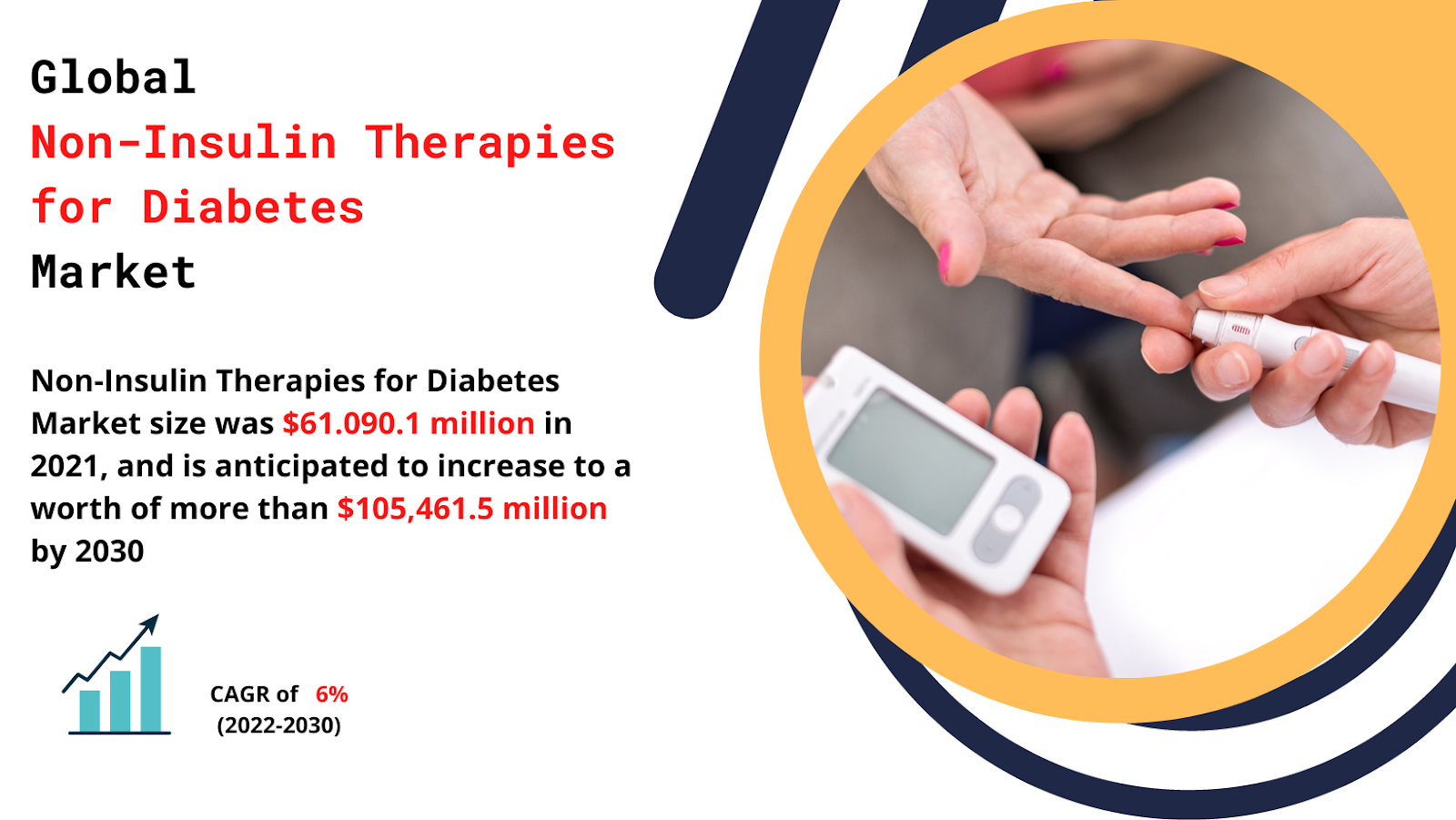Press Release
Non-Insulin Therapies for Diabetes Market Analysis, Key Company Profiles, Types, Applications and Forecast

Non-Insulin Diabetes Therapies are prescribed to the person whose glucose level is high and cannot be controlled by diet and exercise.
Non-insulin therapies are recommended to the patients who are suffering from type 2 diabetes, in which the body is either not able to produce enough insulin or is unable to efficiently use the insulin which is produced. Non-insulin medication has a different mechanism of action. They reduce the blood glucose level and maintain that level to the ideal glycaemic control.
For instance, some agents raise the insulin release from pancreatic cells (Sulfonylureas), whereas a few agents raise the glucose uptake by the periphery and decrease hepatic glucose output (Biguanides). Similarly, certain agents lead to slow starch digestion in the small intestine (alpha-glucosidase inhibitors), likewise, some medication block certain enzymes in order to reduce the post-meal sugar.
Global Non-Insulin Therapies for Diabetes Market Forecast:
The Global Non-Insulin Diabetes Therapies Market size was at US$ 16.26 Billion in 2021, and it is predicted that it will reach a valuation of US$ 26.55 Billion by the end of 2030 with an annual development rate (CAGR) of 5.6% between 2022 and 2030.
Global Non-Insulin Therapies for Diabetes Market Overview:
Rise in the number of people affected by Diabetes Type 2 is the key factor aiding market growth. The number of affected people is expected to increase to 642 million by 2040. Furthermore, the progression of the market is also credited to the engagement of companies in developing medicines with lesser side effects. Non-insulin drugs are injected into the body, to help liver in producing insulin. Previously, insulin type drugs ruled the market, but it is expected that very soon, the market will be dominated by Non-Insulin drugs. The market is anticipated to grow rapidly, and this expansion is ascribed to the rise in the number of diabetes patients, which is caused due to the change in lifestyle and food habits.
Producing a drug which has lesser side effect and is more effective than the currently used drugs are the primary challenges for this market. People are still not aware of the benefits of these drugs. Since diabetes is a common disease, it has been difficult to make this drug available to people from all classes. Another big challenge is to make people aware of the functioning and uses of drugs. The key market players of this segment are located in a few regions only; hence market penetration of the drug is not so deep, which has resulted in less awareness and low sales. Furthermore, the market is also being restricted due to insignificant government initiatives towardsincreasing the cognizance of the masses.
Global Non-Insulin Therapies for Diabetes Market: Key Drivers
Growing Prevalence of Non-Invasive Treatments Will Drive the Growth
The increasing worldwide rate and prevalence of diabetes are relied upon to fuel the progression of the non-insulin treatments for diabetes, Non-insulin treatments are mainly used in the type 2 diabetes, representing a major share of worldwide diabetes cases. As per the Diabetes Atlas published in 2017 by the International Diabetes Federation (IDF), the majority of the patients out of 425 million diabetic patients had type 2 diabetes. As per the World Health Organisation (WHO) 2017 report, among the non-transferable illness, diabetes is one of the main three reasons for death. These are the primary factors that are responsible for the Non-Insulin Markets growth.
New Product Launches to Drive the Growth
Organizations have been propelling new items and mix treatments in the market, which is counted upon to drive the progression of the worldwide non-insulin treatments for the diabetes market.
For instance, in 2017, the Food and Drug Administration (FDA) approved Novo Nordisk’s Ozempic (semiglutide), which is before seven days GLP-1 simple, would make patient consistent.
In December 2017, FDA approved ertugliflozin manufactured by Merck and Co. In January 2018, Pfizer Inc., the European Medicines Agency (EMA), was allowed to endorse the equivalent in the European region.
Get Exclusive Sample Copy of This Report Here
Key Market Segmentation of the Global Non-Insulin Therapies for Diabetes Market:
Global Non-Insulin Therapies for Diabetes Market can be divided into Drug Types, Route of Administration, Distribution Channel, and Geographical landscapes, etc.
Non-Insulin Therapies for Diabetes Market Segmentation By Drug Type:
- Sulphonylureas
- Amylin Agonists
- GLP-1 Agonists & Analogs
- Biguanides
- Glinides & Meglinitides
- Sodium-Glucose cotransporter 2 (SGLT2) Inhibitors
- Thiazolidinediones (or Glitazones or TZDs
- Alpha-Glucosidase Inhibitors
- Dipeptidyl Peptidase-4 (DPP4) Inhibitors
Non-Insulin Therapies for Diabetes Market Segmentation By Route of Administration:
- Oral
- Intramuscular
Non-Insulin Therapies for Diabetes Market Segmentation By Distribution Channel:
- Retail Pharmacy
- Hospital Pharmacy
- Online Pharmacy
Non-Insulin Therapies for Diabetes Market Segmentation By Geographical Landscape:
- North America
- Europe
- Asia Pacific
- South America
- Middle East and Africa
Major Key Players in the Global Non-Insulin Therapies for Diabetes Market Are:
- Tobira (New Jersey),
- Eli Lilly and Sumitomo Dainippon Pharma (Japan),
- Novo Nordisk A/S (Denmark),
- The Takeda Pharmaceutical Company (Japan),
- Sanofi SA (China),
- Mannkind Corporation (California),
- Bristol-Myers Squibb (New York),
- AstraZeneca plc (U.K),
- Boehringer Ingelheim (Germany)
- Bayer AG (Germany).
Interested in purchasing this Report? Click here
The Covid-19 Impact Analysis:
The COVID-19 pandemic brought about a major global crisis and the rising number of new positive cases were a cause for concern for the whole world. The coronavirus and its effects on the body were being studied by scientists and pharmaceutical companies worldwide. The coronavirus had severely affected many people having heart ailments, diabetes and other co-morbidities.
Therefore, the non-insulin drug market witnessed significant growth during the pandemic. People needed to treat their diabetes so that coronavirus did not become a deadly catalyst that harshly affected the body. The lockdown stopped the supply and demand chain from being at the same level, and therefore the gap created between supply and demand was still needed to be filled. Due to indefinite lockdowns, diabetic patients could not see their doctor as the people’s movement was prohibited; therefore, it hampered the progression of the Non-Insulin Therapies market.
About We Market Research
We Market Research is an established market analytics and research firm with a domain experience sprawling across different industries. We have been working on multi-county market studies right from our inception. Over the time, from our existence, we have gained laurels for our deep rooted market studies and insightful analysis of different markets.
Our strategic market analysis and capability to comprehend deep cultural, conceptual and social aspects of various tangled markets has helped us make a mark for ourselves in the industry. We Market Research is a frontrunner in helping numerous companies; both regional and international to successfully achieve their business goals based on our in-depth market analysis. Moreover, we are also capable of devising market strategies that ensure guaranteed customer bases for our clients.
-

 Business6 days ago
Business6 days agoUS Stock Market Soars on Positive Jobs Data and Trade Optimism
-

 Healthcare7 days ago
Healthcare7 days agoMajor Cuts to U.S. Health Programs Raise Concerns Over Public Health Tracking
-

 Business4 days ago
Business4 days agoS&P 500 Rallies as Fed Holds Rates Steady Amid Trade Talks
-

 Stock Market5 days ago
Stock Market5 days agoUS Stock Market Dips as Tariff Fears Resurface
-

 Civil Rights4 days ago
Civil Rights4 days agoSupreme Court Upholds Controversial Ban on Transgender Military Service
-

 Politics6 days ago
Politics6 days agoHouse Passes Controversial Trump Budget Bill Amidst Bipartisan Tensions
-

 Child Welfare5 days ago
Child Welfare5 days agoVenezuelan Mother Claims U.S. Government Kidnapped Her Daughter After Deportation
-

 Press Release3 days ago
Press Release3 days agoCyberCatsCoin (CYBCC) Set to Launch Presale – A Fresh Meme Coin with Real Utility














